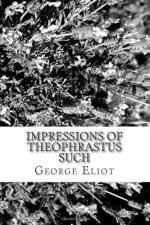These characteristics are the very opposite of such as yield a fine imagination, which is always based on a keen vision, a keen consciousness of what is, and carries the store of definite knowledge as material for the construction of its inward visions. Witness Dante, who is at once the most precise and homely in his reproduction of actual objects, and the most soaringly at large in his imaginative combinations. On a much lower level we distinguish the hyperbole and rapid development in descriptions of persons and events which are lit up by humorous intention in the speaker—we distinguish this charming play of intelligence which resembles musical improvisation on a given motive, where the farthest sweep of curve is looped into relevancy by an instinctive method, from the florid inaccuracy or helpless exaggeration which is really something commoner than the correct simplicity often depreciated as prosaic.
Even if high imagination were to be identified with illusion, there would be the same sort of difference between the imperial wealth of illusion which is informed by industrious submissive observation and the trumpery stage-property illusion which depends on the ill-defined impressions gathered by capricious inclination, as there is between a good and a bad picture of the Last Judgment. In both these the subject is a combination never actually witnessed, and in the good picture the general combination may be of surpassing boldness; but on examination it is seen that the separate elements have been closely studied from real objects. And even where we find the charm of ideal elevation with wrong drawing and fantastic colour, the charm is dependent on the selective sensibility of the painter to certain real delicacies of form which confer the expression he longed to render; for apart from this basis of an effect perceived in common, there could be no conveyance of aesthetic meaning by the painter to the beholder. In this sense it is as true to say of Fra Angelico’s Coronation of the Virgin, that it has a strain of reality, as to say so of a portrait by Rembrandt, which also has its strain of ideal elevation due to Rembrandt’s virile selective sensibility. To correct such self-flatterers as Callista, it is worth repeating that powerful imagination is not false outward vision, but intense inward representation, and a creative energy constantly fed by susceptibility to the veriest minutiae of experience, which it reproduces and constructs in fresh and fresh wholes; not the habitual confusion of provable fact with the fictions of fancy and transient inclination, but a breadth of ideal association which informs every material object, every incidental fact with far-reaching memories and stored residues of passion, bringing into new light the less obvious relations of human existence. The illusion to which it is liable is not that of habitually taking duck-ponds for lilied pools, but of being more or less transiently and in varying degrees so absorbed




